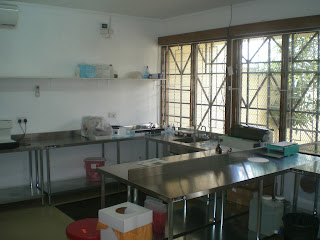James Kelley, PhD, MD
Department of Pathology
Brigham and Women’s Hospital
Like most visitors to southern Africa, my first stop goes through Johannesburg – the “city of gold”. This megalith of 7 million people conjures images of apartheid and armed home invasions; however, the people are as friendly and warm as its summer weather. After all, this is the home of Nelson Mandela and the World Cup. Everyone I meet welcomes me to South Africa and seems genuinely interested that I enjoy visiting their country – even a man walking down my street with an AK47 on his shoulder did not rob me but simply said “whatzit” with a smile.

Jo’burg is a city of contrasts: I have visited townships where ninety families share one portable toilet and have browsed through shopping malls with Gucci and Prada. I am living in Sandton, a northern suburb that generates over 10% of the GDP for all of Africa. The wealth, quality of living, and flashiness here make Boston look like a poor provincial town. My guesthouse has a large garden with digital cable, wireless internet, and uniformed maids cleaning and cooking for me. Not the typical global health experience. However, it resembles a self-imposed prison situated behind a ten-foot concrete wall with electrified fence that hums like a mosquito zapper.
Of the multitude of things on offer in Johannesburg – transfusion medicine is one that is limited. It doesn’t really exist as a field in Africa. Physicians who specialize in blood banking are usually internists who took an interest in the subject and learned informally. There is only one postgraduate program in transfusion medicine on the continent, and it is a distance learning part-time course.
Given the paucity of formal blood banking expertise, I was curious as to how blood banks function given the financial constraints, government corruption, widespread transfusion transmissible disease prevalence, and cultural attitudes in Africa. I am lucky to be hosted by an organization, Safe Blood for Africa, a non-profit group based in Georgetown with their operational office located in Sandton. They have networked me with various hospitals and blood services throughout the continent to visit and experience the realities and challenges of operating a transfusion service in Africa. I am also working with them to help develop educational programs for training clinicians in proper blood banking practices.
Trauma bay at Milbank Hospital (Johannesburg, South Africa). This is a private hospital that caters to those who can afford private medical insurance and foreigners.
They have told me stories of aggressive surgeons barging into a blood bank and taking a unit for transfusion without appreciating that the ABO group did not match and of nurses hanging a bag of blood for a child, transfusing half the unit, putting it back in the refrigerator in non-sterile conditions, and then transfusing the rest of the unit to another patient later in the week. Both resulted in fatalities. Developing programs to educate clinicians could save numerous lives.
The first stop on my tour was the South African National Blood Service (SANBS). This organization has resources and expertise atypical of the rest of the continent. The medical director is a board certified internist trained in Washington. Their standard of care is more similar to what we offer in the US. They perform serological and nucleic acid testing for HIV, HBV, and HCV on all donors, reducing the risk of transmission to about 1:400,000 transfusions. (We advertise rates of 1:2,000,000 at the Brigham with our procedures; however, we don’t have a HIV prevalence of 20% in our general population.) They separate blood components and provide advice to clinicians across the country regarding transfusion reactions and blood products.
I was able to watch their testing and component processing and compare it to our procedures at BWH – all were very similar except their equipment was slightly older. Their physicians also remotely oversee therapeutic apheresis and stem cell collections, which will be driven back to their main offices, processed, and driven to the recipient’s hospital for infusion. I observed the apheresis clinics and again found their equipment and protocols almost identical to what we use at BWH. However, I am assured that the standard available in South Africa and Johannesburg in particular is not typical of the rest of the continent. I am excited to find out for myself ….
Therapeutic apheresis clinic in Auckland Park (Gauteng) South Africa. We had just finished a hematopoietic stem cell collection.












